Burmese kyat
The kyat (/kiˈɑːt/, US: /ˈtʃɑːt/ or /ˈkjɑːt/;[1] Burmese: ကျပ် [tɕaʔ]; ISO 4217 code MMK) is the currency of Myanmar (Burma). It is often abbreviated as "K" (singular or plural) or "Ks" (plural), which is placed before or after the numerical value, depending on author preference.
| Burmese kyat | |||||
|---|---|---|---|---|---|
| |||||
| ISO 4217 | |||||
| Code | MMK | ||||
| Denominations | |||||
| Subunit | |||||
| 1⁄100 | pya | ||||
| Symbol | K | ||||
| Banknotes | |||||
| Freq. used | K50, K100, K200, K500, K1000, K5000, K10,000. | ||||
| Rarely used | 50 pyas, K1, K5, K10, K20 | ||||
| Coins | |||||
| Rarely used | K1, K5, K10, K50, K100. | ||||
| Demographics | |||||
| User(s) | |||||
| Issuance | |||||
| Central bank | Central Bank of Myanmar | ||||
| Website | www | ||||
| Valuation | |||||
| Inflation | 7% | ||||
| Source | The World Factbook, 2016 est. | ||||
The term kyat derives from the ancient Burmese unit kyattha, equal to 16.3 grams of silver.[2][3]
Current MMK exchange rates
From 2001-2012, the official exchange rate varied between 5.75 and 6.70 kyats per US dollar (8.20 to 7.00 kyats per euro). However, the street rate (black market rate), which more accurately took into account the standing of the national economy, has varied from 750 kyats to 1335 kyats per USD (985 to 1475 kyats per EUR). The black market exchange rates (USD to MMK) decrease during the peak of the tourist season in Burma (December to January).
On 2 April 2012, the Central Bank of Myanmar announced that the value of the kyat against the US dollar would float, setting an initial rate of K 818 per US dollar.[4]
On 20 March 2013, the Finance Ministry announced that it would abolish Foreign Exchange Certificates (FEC), which were mandatory for tourists to buy at least US$200 worth of until 2003, a measure used to stop visitors from exchanging on the black market.[5]
| Current MMK exchange rates | |
|---|---|
| From Google Finance: | AUD CAD CHF EUR GBP HKD JPY USD |
| From Yahoo! Finance: | AUD CAD CHF EUR GBP HKD JPY USD |
| From XE.com: | AUD CAD CHF EUR GBP HKD JPY USD |
| From OANDA: | AUD CAD CHF EUR GBP HKD JPY USD |
| From fxtop.com: | AUD CAD CHF EUR GBP HKD JPY USD |
History
First kyat, 1852-1889
The kyat was a denomination of both silver and gold coinages in Burma until 1889. It was divided into 20 pe, each of 4 pya, with the mu and mat worth 2 and 4 pe, respectively. Nominally, 16 silver kyats equal 1 gold kyat. The silver kyat was equivalent to the Indian rupee, which replaced the kyat after Burma was conquered by the British.
Second Kyat, 1943-1945
When the Japanese occupied Burma in 1942, they introduced a currency based on the rupee. This was later replaced by banknotes in all kyat denominations. This kyat was subdivided into 100 cents. The currency became worthless at the end of the war when the Burmese rupee was reintroduced in 1945.
Third kyat, 1952-
The present kyat was introduced on 1 July 1952. It replaced the rupee at par. Decimalisation also took place, with the kyat subdivided into 100 pya.
Coins
First kyat
In 1852, Mindon, the second last king of Burma, established the Royal Mint in Mandalay (Central Burma). The dies were made in Paris. Silver coins were minted in denominations of 1 pe, 1 mu (2 pe), 1 mat (4 pe), 5 mu (10 pe) and 1 kyat, with gold 1 pe and 1 mu. The obverses bore the Royal Peacock Seal, from which the coins got their name. The reverse contained the denomination and mint date (in the Burmese era, which starts from AD 638). In the 1860s and 1870s, lead coins were issued for 1⁄8 and 1⁄4 pya, with copper, brass, tin and iron 1⁄4 pe (1 pya) and copper 2 pya. Further gold coins were issued in 1866 for 1 pe, 2 1⁄2 mu and 1 kyat, with 5 mu issued in 1878.
Second kyat
No coins were issued for this currency.
Third kyat
In 1956, coins were introduced in denominations of 1, 5, 10, 25 and 50 pyas and 1 kyat. The new coins bore the same obverse figure of the Chinthe from the Second kyat coins and the same reverse design, with the value of the coin in Myanmar writing and numerals surrounded by Myanmar flower designs.
| 1956-1966 issued coins [6] | |||||||||
|---|---|---|---|---|---|---|---|---|---|
| Image | Value | Technical parameters | Description | Date of issue | |||||
| Obverse | Reverse | Diameter | Mass | Composition | Edge | Obverse | Reverse | ||
 |
1 pya | 18 mm | 2.2 g | Bronze 90% copper 10% zinc |
Plain | Chinthe | Value (digit),Value (writing), year of minting, Myanmar flower designs | 1956 | |
 |
 |
5 pyas | 19.5 mm | 3.17 g | Copper-nickel | Plain | Chinthe | Value (digit),Value (writing), year of minting, Myanmar flower designs | 1956 |
 |
10 pyas | 19.5 mm | 4.46 g | Copper-nickel | Plain | Value (digit),Value (writing), year of minting, Myanmar flower designs | 1956 | ||
| 25 pyas | 24.1 mm | 6.78 g | Copper-nickel | Plain | Value (digit),Value (writing), year of minting, Myanmar flower designs | 1956 | |||
| 50 pyas | 26 mm | 7.8 g | Copper-nickel | Security edge | Value (digit),Value (writing), year of minting, Myanmar flower designs | 1956 | |||
| 1 kyat | 30.5 mm | 11.65 g | Copper-nickel | Security edge | Value (digit),Value (writing), year of minting, Myanmar flower designs | 1956 | |||
| These images are to scale at 2.5 pixels per millimetre. For table standards, see the coin specification table. | |||||||||
In 1966, all coins were redesigned to feature Aung San on the obverse and were all changed in composition to aluminium. Furthermore, the coins were slightly reduced in size. However, they retained the same shapes and overall appearance of the previous series of coins. These were circulated until being discontinued in 1983.
In 1983, a new series of coins was issued in bronze or brass 5, 10, 25, 50 pyas and cupro-nickel 1 kyat. Although the 25 pyas were initially round, it was later redesigned as hexagonal due to size and appearance confusions with the 10 and 50 pyas. These would be the last official series of coins to be issued under the name of "Burma."
1 pya coins were last minted in 1966, with the 5 and 25 pyas last minted in 1987 and the 10 and 50 pyas in 1991.
In 1999, a new series of coins was issued in denominations of bronze 1 kyat, brass 5 and 10 kyats, and cupro-nickel 50 and 100 kyats under the name "Central Bank of Myanmar." These are also the first coins of Burma to depict Latin letters. These coins were intended for vendors and services as an alternative to large amounts of worn out, low denomination banknotes. High inflation has since pushed these coins out of circulation.
In late 2008, the Myanmar government announced that new 50 and 100 kyat coins would be issued. According to newspaper articles, the new 50 kyat coin would be made of copper, with the usual Burmese lion on the obverse and the Lotus Fountain from Naypyidaw on the reverse. The 100 Kyat coin would be of cupro-nickel and depict the Burmese lion on the obverse and the value on the reverse.
| 1991 Series | ||||||||
|---|---|---|---|---|---|---|---|---|
| Image | Value | Technical parameters | Description | Date of first minting | ||||
| Diameter | Weight | Composition | Edge | Obverse | Reverse | |||
| [7] | 10 pyas | 20.4 mm | Brass | Rice plant, "Central Bank of Myanmar" in Burmese | Value in Burmese numerals | 1991 | ||
| 50 pyas | 24.6 mm | Brass | Rice plant, "Central Bank of Myanmar" in Burmese | Value in Burmese numerals | 1991 | |||
| 1999 Series | ||||||||
| [8] | 1 kyat | 19.03 | 2.95 | Bronze | Plain | Chinthe, "Central Bank of Myanmar" and value in Burmese | Bank title and value in English and Arabic numerals | 1999 |
| [9] | 5 kyats | 20 mm | 2.73 g | Brass | Plain | Chinthe, "Central Bank of Myanmar" and value in Burmese | Bank title and value in English and Arabic numerals | 1999 |
| [10] | 10 kyats | 22.3 mm | 4.45 g | |||||
| [11] | 50 kyats | 23.85 mm | 5.06 g | Cupronickel | Reeded | Chinthe, "Central Bank of Myanmar" and value in Burmese | Bank title and value in English and Arabic numerals | 1999 |
| [12] | 100 kyats | 26.8 mm | 7.52 g | |||||
| For table standards, see the coin specification table. | ||||||||
Banknotes
First kyat
No banknotes was issued for this currency.
Second kyat
The Burma State Bank issued notes for 1, 5, 10 and 100 kyats in 1944, followed by a further issue of 100 kyat notes in 1945.
| 1944/1945 Series | |||||||||
|---|---|---|---|---|---|---|---|---|---|
| Image | Value | Dimensions | Main Color | Description | Date of issue | Remark | |||
| Obverse | Reverse | Obverse | Reverse | Watermark | |||||
 |
 |
K1 | 109 × 63 mm | Blue | Peacock and "1 kyat" written in Myanmar with rising sun in background | Mandalay Royal Palace | "Bamar" written in Myanmar language embedded in guilloché pattern | 1944 | |
 |
K5 | 130 × 72 mm | Red | Peacock and "5 kyats" written in Myanmar with rising sun in background | |||||
 |
 |
K10 | 146 × 84 mm | Green | Peacock and "10 kyats" written in Myanmar with rising sun in background | ||||
 |
 |
K100 | 160 × 90 mm | Bright Orange | Peacock and "100 kyats" written in Myanmar with rising sun in background | ||||
 |
 |
K100 | 155 × 95 mm | Dark blue | Peacock and "100 kyats" written over Myanmar "100" numerals with image of Head of State Ba Maw on right | Mandalay Royal Palace in center bordered by Myanmar nāgas with "100" in Myanmar numerals on left and right | Head of State Ba Maw's image | 1945 | |
| For table standards, see the banknote specification table. | |||||||||
Third kyat
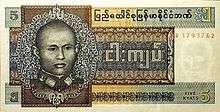
In 1952, the Union Bank of Burma formed a Currency Board which took over control of the issuing of currency and a more important change to the currency was the introduction of the decimal system in which 1 kyat was decimalised into 100 pyas.[13] On 12 February 1958, the Union Bank of Burma introduced the first kyat notes, in denominations of 1, 5, 10 and 100 kyats. These were very similar in design to the last series of rupee notes, issued earlier. Later on, 21 August 1958, 20 and 50 kyats notes were introduced. The 50 and 100 kyat notes were demonetised on 15 May 1964. This was the first of several demonetisations, ostensibly carried out with the aim of fighting black marketeering.
1965-1971
The Peoples Bank of Burma took over note production in 1965 with an issue of 1, 5, 10 and 20 kyats notes.
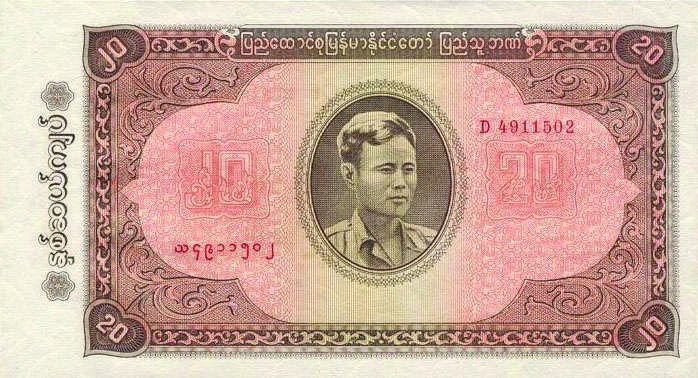
| 1965 Series | ||||||||
|---|---|---|---|---|---|---|---|---|
| Image | Value | Dimensions | Main Color | Description | Date of issue | |||
| Obverse | Reverse | Obverse | Reverse | Watermark | ||||
 |
 |
K1 | 115 × 66 mm | Purple and grey | General Aung San | Inle Lake fisherman | Series of semi-circles | 30 April 1965 |
 |
 |
K5 | 150 × 70 mm | Green | Farmer and cow | Pattern throughout paper | 1965 | |
 |
 |
K10 | 159 × 81 mm | Red | Woman picking cotton | |||
 |
 |
K20 | 169 × 90 mm | Brown | Cultivating tractor | |||
1972-1988
In 1972, the Union of Burma Bank took over note issuance, with notes introduced between 1972 and 1979 for 1, 5, 10, 25, 50 and 100 kyats. The notes were printed by the Security Printing Works in Wazi, Upper Burma (established c. 1972) under the technical direction of the German printing firm Giesecke & Devrient.
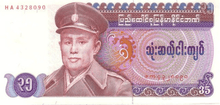
On 3 November 1985, the 50-, and 100-kyats notes were demonetized without warning, though the public was allowed to exchange limited amounts of the old notes for new ones. All other denominations then in circulation remained legal tender. On 10 November 1985, 75-kyats notes were introduced, the odd denomination possibly chosen because of dictator general Ne Win's predilection for numerology; the 75-kyats note was supposedly introduced to commemorate his 75th birthday. It was followed by the introduction of 15- and 35- kyats notes on 1 August 1986.
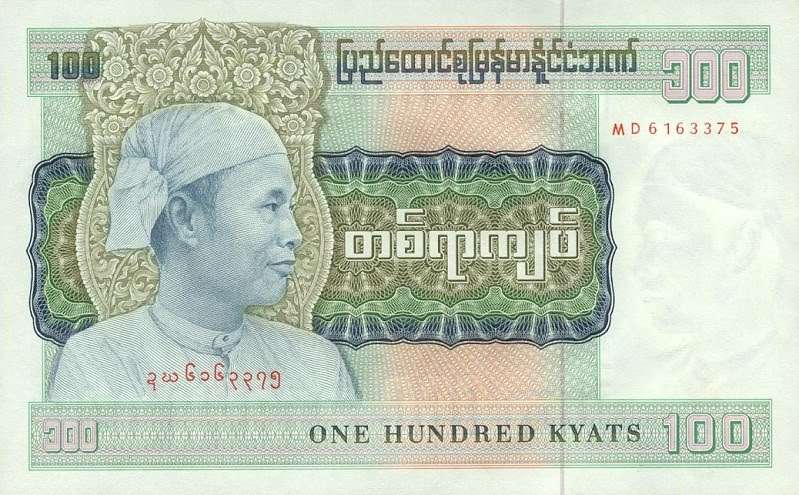
Only two years later, on 5 September 1987, the government demonetised the 25-, 35-, and 75-kyats notes without warning or compensation, rendering some 75% of the country's currency worthless and eliminating the savings of millions of Burmese. On 22 September 1987, banknotes for 45 and 90 kyats were introduced, both of which incorporated Ne Win's favourite number, nine. The resulting economic disturbances led to serious riots and eventually a coup d'état in 1988 by General Saw Maung.
| 1972-1987 Series | ||||||||
|---|---|---|---|---|---|---|---|---|
| Image | Value | Dimensions | Main Color | Description | Date of | |||
| Obverse | Reverse | Obverse | Reverse | issue | issue suspension | |||
 |
 |
K 1 | 124 × 60 mm | Green | General Aung San | Weaving Loom | 31 October 1972 | Fall into disuse, wear and tear |
 |
 |
K 5 | 136 × 70 mm | Blue | Palm Tree | 31 October 1973 | Fall into disuse, wear and tear | |
 |
 |
K 10 | 146 × 80 mm | Reddish Brown | Ceremonial Offering Bowl | 30 June 1973 | Fall into disuse, wear and tear | |
 |
 |
K 15 | 149 × 71 mm | Light green | Zawgyi wood carving | 1 August 1986 | Fall into disuse, wear and tear | |
 |
 |
K 25 | 155 × 90 mm | Orange | Pyinsarupa | 3 November 1985 | 5 September 1987 | |
| K 35 | 155 × 74 mm | Violet | Standing Nat Thar | 1 August 1986 | 5 September 1987 | |||
 |
 |
K 45 | 158 × 77,5 mm | Blue-green | Thakin Po Hla Gyi | Oil field workers and oil drills | 22 September 1987 | Fall into disuse, wear and tear |
 |
 |
K 50 | 166 × 100 mm | Yellow-Brown | General Aung San | Law Ka Nat | July 1979 | 3 November 1985 |
 |
 |
K 75 | 161 × 77 mm | Brown | 10 November 1985 | 5 September 1987 | ||
 |
 |
K 90 | 167 × 80 mm | Light green | Saya San | Farmers and bullock cart | 22 September 1987 | Fall into disuse, wear and tear |
 |
 |
K 100 | 176 × 110 mm | Light green | General Aung San | Saung gauk | 1 August 1976 | 3 November 1985 |
| For table standards, see the banknote specification table. | ||||||||
Banknotes of 50 pyas, 1 kyat and 5 kyats are rare. Most daily transactions are round up to nearest 10 kyats.
1989 to present
Following the change of the country's name to Myanmar on 20 June 1989, new notes began to be issued, but returning to more useful or practical denominations. This time, the old notes were not demonetised, but simply allowed to fall into disuse through inflation as well as wear and tear. On 1 March 1990, 1-kyat notes were issued, followed by 200-kyats notes on 27 March 1990. On 27 March 1994, notes for 50 pyas, 20, 50, 100, and 500 kyats were issued, followed on 1 May 1995, by new 5- and 10-kyats notes. 1,000-kyats notes were introduced in November 1998.
In 2003, rumours of another pending demonetisation swept through the country, resulting in the junta issuing official denials, but this time, the demonetization did not materialise. In 2004, the sizes of the 200, 500, and 1,000 kyats notes were reduced in size (to make all Burmese banknotes uniform in size) but larger notes were allowed to remain in circulation. 50 pyas, 1, 5, 10 and 20 kyats banknotes are now rarely seen, because of their low value.followed on 4 January 2020, by new 1000-kyats notes.
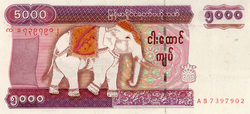
On 1 October 2009, 5,000-kyats banknotes were issued measuring 150 x 70 mm. Along the top front is written Central Bank of Myanmar in Burmese, and in the centre is a white elephant. On the back is a picture of Pyidaungsu Hluttaw (Assembly of the Union) legislature buildings, the Central Bank of Myanmar with "FIVE THOUSAND KYATS 5000" written in English. This new denomination is five times larger than the previous largest denomination.[14] Public response has been mixed, with some welcoming a higher value note reducing the number of banknotes which need to be carried. Other responses have suggested a widespread fear that this will simply fuel the current rate of inflation, which was supported by a jump in the black market exchange rates following the public announcement of this change.[15][16] The Central Bank of Myanmar introduced new 5,000-kyats banknotes on 1 October 2014 to prevent counterfeiting, it reported on 18 September. The revised notes are varnished and have enhancements made to the printing, watermarks, and security thread and is the same size, colour and design as the 2009 issue, which continues to be used. The new notes will last longer and be cleaner, the central bank said. The announcement followed recent media reports that counterfeit Ks 5,000 and Ks 10,000 banknotes were circulating widely. Police seized eight counterfeit Ks 10,000 bills and a printer allegedly used to make them on 12 September in Yangon’s Tamwe Township.[17]
On 9 June 2012, the Central Bank announced that 10,000-kyats notes would be introduced into circulation to better facilitate financial transactions in a largely cash-oriented economy. They were issued on 15 June 2012.[18][19]
Ever since the Third Kyat was introduced, the Myanmar currency has no indication of the date in which the note came into circulation nor the signature of the issuing authority.
| Current Series | |||||||||
|---|---|---|---|---|---|---|---|---|---|
| Image | Value | Dimensions | Main Color | Description | Date of issue | Remark | |||
| Obverse | Reverse | Obverse | Reverse | Watermark | |||||
 |
 |
50 pyas | 110 × 55 mm | Obverse: Purple and orange Reverse: Multicolor |
Saung gauk | Guilloché pattern | "BCM" | 27 March 1994 | |
 |
 |
K1 | Orange | Bogyoke Aung San | Guilloché pattern | Bogyoke Aung San | 1 March 1990 | ||
 |
 |
K1 | Blue-purple | Chinthe | Boat-rowing at Kandawgyi Lake, Yangon | "BCM" | 31 October 1996 | ||
 |
 |
K5 | 130 × 60 mm | Brown and blue | Chinlone cane ball game | Chinthe | 1 May 1995 | ||
| Chinthe bust over value | 1997 | ||||||||
 |
 |
K10 | Purple | A karaweik (royal regalia boat) | Chinthe | 1 May 1995 | |||
| Chinthe bust over value | 1997 | ||||||||
 |
 |
K20 | 145 × 70 mm | Green | People's Park and Elephant Fountain, Yangon | Chinthe bust over value | 27 March 1994 | ||
 |
 |
K50 | Orange-brown | Lacquerware artisan | Chinthe | 27 March 1994 | |||
| Chinthe bust over value | 1997 | ||||||||
 |
 |
K100 | Blue, green, and pink | Temple renovation | Chinthe | 27 March 1994 | |||
| Chinthe bust over value | |||||||||
| [20] | [21] | K200 | 165 × 80 mm | Dark green | Elephant teak-logger | Chinthe | 27 March 1990; 1998 | Value below watermark | |
| Chinthe bust over value | |||||||||
 |
 |
150 × 70 mm | Chinthe bust over value | 11 December 2004 | Value above watermark | ||||
| [22] | [23] | K500 | 165 × 80 mm | Purple and brown | A General Mahabandoola statue being painted | Chinthe | 27 March 1994 | Value above watermark | |
| Chinthe bust over value | |||||||||
 |
 |
150 × 70 mm | Chinthe bust over value | 10 October 2004 | Value below watermark | ||||
 |
 |
K1000 | 165 × 80 mm | Green and purple | Ministry of Finance and Revenue | Chinthe | November 1998 | Value above watermark | |
| Chinthe bust over value | |||||||||
 |
 |
150 × 70 mm | Chinthe bust over value | 11 October 2004 | Value below watermark | ||||
| K1000 | 150 × 70 mm | blue | Aung San | Pyidaungsu Hluttaw (Assembly of the Union) legislature buildings in Zeya Theddhi Ward of Naypyidaw | Aung San bust over value | 4 January 2020[24] | Value above watermark | ||
 |
 |
K5000 | 150 × 70 mm | Orange and pink | Elephant | Pyidaungsu Hluttaw (Assembly of the Union) legislature buildings in Zeya Theddhi Ward of Naypyidaw | Elephant profile over value | 1 October 2009[25] | Value above watermark |
 |
 |
K10,000 [26] | 150 × 70 mm | Blue, red, purple, green, brown and yellow | Modified State Seal of Myanmar (Features a lotus and a pair of elephant, instead of a star, a pair of Chinthe lion and the Armiger as in the Original State Seal) | Mandalay Royal Palace Moat | Lotus Flower profile over value | 15 June 2012 | Value above watermark |
Foreign Exchange Certificates
In 1993, Myanmar began issuing foreign exchange certificates (FEC) in denominations of 1, 5, 10, and 20 kyats. These were exchanged on a parity ratio with the United States Dollar and were valued separately from the regular kyat. Conversion of foreign currency into kyats was made illegal as exchange rates were set artificially high. During much of this period, two valuations of the Myanmar kyat emerged; The official rate which averaged around 6 MMK = 1 USD, and the black market rate which averaged tens of times higher. Foreign visitors to Myanmar could only transact currency in FEC's or could only obtain kyats at the artificially high official rates. Illegal peddlers often had to be sought out to exchange currency.
On 1 April 2012, the Government of Myanmar began allowing for a managed float of the kyat and legalised the use and exchange of foreign currencies in Myanmar to better reflect the global exchange rates, attract investment, and to weaken the black markets. On 20 March 2013, the government announced the discontinuation and gradual withdrawal of FEC's.
Re-design Proposal
Following the removal of General Aung San's portraits from the banknotes of the Myanmar kyat in 1987, there have been calls by both the public and opposition politicians to reinstate them, as well as criticizing the use of animals on banknotes in circulation. Writer U Nyi Maung notes that foreign countries use portraits of their national leaders and heroes on their banknotes, such as Thailand, and encourages the reinstatement of General Aung San's portrait on the Kyat to remember his legacy. In October 2017, a proposal was submitted by National League for Democracy MP U Aung Khin Win to debate the issue in the Pyithu Hluttaw.[27]
While the Central Bank of Myanmar argues that the cost of reprinting new notes bearing the General's portrait would be monumental considering Myanmar's current economic situation, U Aung Khin Win stated that new notes would only be reprinted to replace damaged notes or in the release of new denominations or size of Kyat banknotes.[27]
The debate on this issue took place in the Pyithu Hluttaw on 17 November 2017. The proposal was wholly rejected by the military bloc, but it was passed with 286 votes for, and 109 against.[28]
References
- Jones, Daniel (2003) [1917], Peter Roach; James Hartmann; Jane Setter (eds.), English Pronouncing Dictionary, Cambridge: Cambridge University Press, ISBN 3-12-539683-2
- Yule, Sir Henry; Burnell, Arthur Coke (30 July 1968). "Hobson-Jobson: A Glossary of Colloquial Anglo-Indian Words and Phrases, and of Kindred Terms, Etymological, Historical, Geographical and Discursive". Munshiram Manoharlal – via Google Books.
- Robinson, Michael; Shaw, Lewis A. (30 July 1980). "The Coins and Banknotes of Burma". M. Robinson and L.A. Shaw – via Google Books.
- "Burma sets currency exchange rate as it floats the kyat". BBC News. 2 April 2012.
- Maierbrugger, Arno (20 March 2013). "Myanmar phases out dollar surrogate". Inside Investor. Retrieved 20 March 2013.
- "Series of Bank Notes and Coins - Central Bank of Myanmar". Cbm.gov.mm.
- "Photographic image" (JPG). Worldcoingallery.com. Retrieved 16 January 2018.
- "Photographic image" (JPG). Worldcoingallery.com. Retrieved 16 January 2018.
- "Photographic image" (JPG). Worldcoingallery.com. Retrieved 16 January 2018.
- "Photographic image" (JPG). Worldcoingallery.com. Retrieved 16 January 2018.
- "Photographic image" (JPG). Worldcoingallery.com. Retrieved 16 January 2018.
- "Photographic image" (JPG). Worldcoingallery.com. Retrieved 16 January 2018.
- "History of Bank Notes - Central Bank of Myanmar". Cbm.gov.mm. Retrieved 16 January 2018.
- Linzmayer, Owen (2012). "Myanmar". The Banknote Book. BanknoteNews.com. San Francisco, California.
- "New Myanmar kyat note". Myanmar2day.com. Retrieved 16 January 2018.
- Myanmar new 5,000-kyat note confirmed BanknoteNews.com, 9 October 2009.
- "Some Interesting Facts About Paper Money". Nutmegcollector.blogspot.com. Retrieved 16 January 2018.
- "Get complete access to The Washington Post online - it's FREE!". The Washington Post. 7 June 2012.
- "Myanmar new 10,000-kyat note confirmed". Banknotenews.com. Retrieved 16 January 2018.
- "Banknote World - World Currency & Paper Money Collectors". Web.archive.org. Archived from the original on 14 April 2008.
- "Banknote World - World Currency & Paper Money Collectors". Web.archive.org. Archived from the original on 14 April 2008.
- "Banknote World - World Currency & Paper Money Collectors". Web.archive.org. Archived from the original on 28 June 2011.
- "Banknote World - World Currency & Paper Money Collectors". Web.archive.org. Archived from the original on 28 June 2011.
- "Central bank to circulate 'Bogyoke Aung San' 1000-Kyat note". elevenmyanmar.com. Retrieved 7 January 2020.
- "Myanmar new 5,000-kyat note confirmed". Banknotenews.com. Retrieved 16 January 2018.
- "Burma to issue 10,000-kyat banknote". Web.archive.org. 31 May 2013. Retrieved 16 January 2018.
- "Aung San returns to Kyat notes". The Myanmar Times. Retrieved 17 November 2017.
- "Gen Aung San to Return to Banknotes Despite Military Disapproval". The Irrawaddy. 17 November 2017. Retrieved 17 November 2017.
- Krause, Chester L.; Clifford Mishler (1991). Standard Catalog of World Coins: 1801–1991 (18th ed.). Krause Publications. ISBN 0873411501.
- Krause, Chester L.; Clifford Mishler (2003). 2004 Standard Catalog of World Coins: 1901–Present. Colin R. Bruce II (senior editor) (31st ed.). Krause Publications. ISBN 0873495934.
- Pick, Albert (1994). Standard Catalog of World Paper Money: General Issues. Colin R. Bruce II and Neil Shafer (editors) (7th ed.). Krause Publications. ISBN 0-87341-207-9.
- Cuhaj, George S. (editor) (2006). Standard Catalog of World Paper Money: Modern Issues 1961-Present (12th ed.). Krause Publications. ISBN 0-89689-356-1.CS1 maint: extra text: authors list (link)

